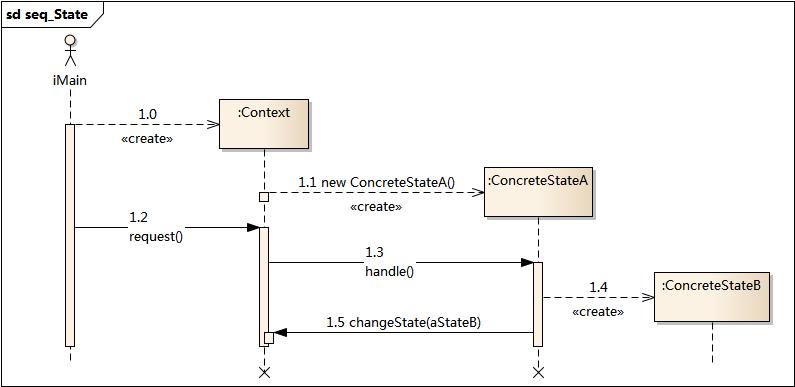状态模式和策略模式的区别
来源:互联网 发布:数据有效性下拉日期 编辑:程序博客网 时间:2024/06/06 21:38
转自:http://blog.csdn.net/ruangong1203/article/details/52514919
状态模式和策略模式的区别
区别主要体现在行为上,而不是结构上,所以,看时序图就能很好的看出两者的区别。
状态模式

看1.4,状态B是状态A创建的,也就是由系统本身控制的。调用者不能直接指定或改变系统的状态转移
所以,状态是系统自身的固有的,调用者不能控制系统的状态转移。比如,一个请假单有“部长审批”-“经理审批”-“审批通过”-“审批不通过”等状态,请假者没有办法将一个部长都还没审批完的请假单提交给经理,这个状态转换只能系统自己完成。
策略模式

看1.5,策略B是调用者指定的,系统自身并不能指定或改变策略。
所以策略是外界给的,策略怎么变,是调用者考虑的事情,系统只是根据所给的策略做事情。这时系统很像是一台电脑,根据指令执行动作,打一鞭子滚一滚。
知识检测
小明中国出发到日本再到美国去旅行,在不同的国家都要做两件事,问候和打招呼,怎么做取决于他在哪个国家。(就是编程时经常碰到的多语言问题了)根据需求,请问该使用哪种模式?开发者写了下面的代码,请问下面的代码是状态模式还是策略模式?
0 0
- 状态模式和策略模式的区别
- 状态模式和策略模式的区别
- 策略模式和状态模式的区别2
- Java中,状态模式和策略模式的区别
- Java中状态模式和策略模式的区别
- 状态模式与策略模式的区别
- Android的策略模式和状态模式
- 设计模式之策略模式与状态模式的区别
- 状态模式和策略模式
- 状态模式和策略模式
- 状态模式和策略模式
- 设计模式:状态模式和策略模式的比较
- 模板模式和策略模式的区别
- 模板模式和策略模式的区别
- 模板模式和策略模式的区别
- 模板模式和策略模式的区别
- 工厂模式和策略模式的区别
- 模板模式和策略模式的区别
- iOS回顾笔记(04) -- UIScrollView的基本使用详解
- 详细解读神经网络十大误解,再也不会弄错它的工作原理
- Linux中Shutdown命令实现定时自动关机
- USB(FS、HS、LS)
- 前端常见排序算法之冒泡算法
- 状态模式和策略模式的区别
- CSDN的开端
- Harris 角點
- java实现顺序表的增加,删除,查找,打印
- Linux 内核设备驱动之GPIO驱动之GPIO 控制器设备描述
- android 按home键回到桌面,然后再次进入app,app重新打开问题
- 定义定制Android动画,让你的APP更炫酷
- ubuntu16.04下NVIDIA GTX965M显卡驱动PPA安装
- python中sys.argv参数用法实例分析


